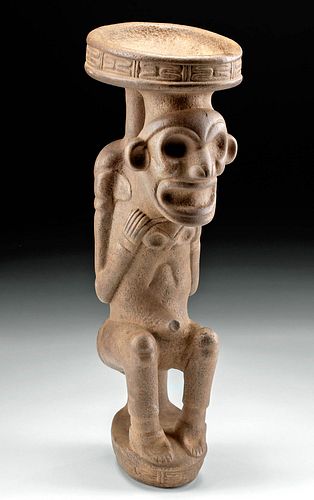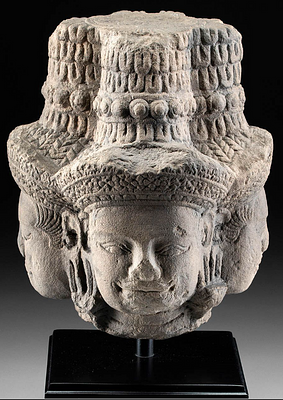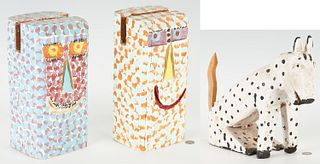Published Taino Stone Cohoba Stand, Shaman w/ Owl
Lot 114
About Seller
Artemis Gallery
686 S Taylor Ave, Ste 106
Louisville, CO 80027
United States
Selling antiquities, ancient and ethnographic art online since 1993, Artemis Gallery specializes in Classical Antiquities (Egyptian, Greek, Roman, Near Eastern), Asian, Pre-Columbian, African / Tribal / Oceanographic art. Our extensive inventory includes pottery, stone, metal, wood, glass and textil...Read more
Estimate:
$7,000 - $10,500
Absentee vs Live bid
Two ways to bid:
- Leave a max absentee bid and the platform will bid on your behalf up to your maximum bid during the live auction.
- Bid live during the auction and your bids will be submitted real-time to the auctioneer.
Bid Increments
| Price | Bid Increment |
|---|---|
| $0 | $25 |
| $300 | $50 |
| $1,000 | $100 |
| $2,000 | $250 |
| $5,000 | $500 |
| $10,000 | $1,000 |
| $20,000 | $2,500 |
| $50,000 | $5,000 |
| $100,000 | $10,000 |
| $200,000 | $20,000 |
About Auction
By Artemis Gallery
Jun 29, 2023
Set Reminder
2023-06-29 10:00:00
2023-06-29 10:00:00
America/New_York
Bidsquare
Bidsquare : Exceptional Antiquities, Ethnographic and Fine Art
https://www.bidsquare.com/auctions/artemis-gallery/exceptional-antiquities-ethnographic-and-fine-art-13031
Artemis Gallery info@artemisgallery.com
Artemis Gallery info@artemisgallery.com
- Lot Description
Pre-Columbian, Hispaniola, Greater Antilles Islands, Taino/ Arawak Indians, ca. 15th to early 16th century CE. An incredible shaman figure that served as both a vehicle and a symbol of Taino hallucinogenic transformation, all skillfully carved from silicified sandstone. A ceremonial stand for a vegetal entheogen known as cohoba, depicting a shaman figure under the influence of the drug. Holding an owl to his chest, the shaman is emaciated with a prominent arched spine, thin shoulders, and bony knees as though fasting. Between his legs is an erect phallus - another sign of cohoba consumption as the drug was known to cause sexual arousal. He displays a drug-induced countenance of gritting teeth and huge, open eyes, as if swelling with tears from the process of inhalation. He sits atop an ovoid plinth, while a discoid platter balances on his head, both adorned by relief decoration of stylized frog symbols. Size: 6.3" L x 4.3" W x 15" H (16 cm x 10.9 cm x 38.1 cm)
The platter acted as a surface on which ground up hallucinogenic powder or paste would have been inhaled by ceremonial participants. The owl he holds is indicative of his shamanic status - owls were considered mediums who guided shamans in their dark endeavors.
Taino art is comprised of many cult objects associated with the worship of "zemis." The term zemi refers to deities, ancestors, or earth spirits. Zemis like this example are believed to be inhabited by powerful spirits. Owners of zemi figures traditionally honored them with offerings of food or precious gifts. Each Zemi had its own identity and name, personality, distinct characteristics, and powers.
Published in “Taino Zemis and Other Heads of State, Rediscovering Caribbean Art” by Larry Roberts, page 285, figure 7.264 (Gaithersburg, MD: Signature Book Printing, 2023).
Provenance: private Roberts collection, Gainesville, Florida, USA, acquired in the late 1970s; ex-Thomas Villanova collection, Miami, Florida, USA and Venezuela; ex-Gerald Murphy collection
All items legal to buy/sell under U.S. Statute covering cultural patrimony Code 2600, CHAPTER 14, and are guaranteed to be as described or your money back.
A Certificate of Authenticity will accompany all winning bids.
We ship worldwide and handle all shipping in-house for your convenience.
#178589Some nicks, pitting and abrasions to surface, as well as a few stable fissures, all commensurate with age.Condition
- Shipping Info
-
All shipping is handled in-house for your convenience. Your invoice from Artemis Gallery will include shipping calculation instructions. If in doubt, please inquire BEFORE bidding for estimated shipping costs for individual items.
-
- Buyer's Premium



 EUR
EUR CAD
CAD AUD
AUD GBP
GBP MXN
MXN HKD
HKD CNY
CNY MYR
MYR SEK
SEK SGD
SGD CHF
CHF THB
THB














